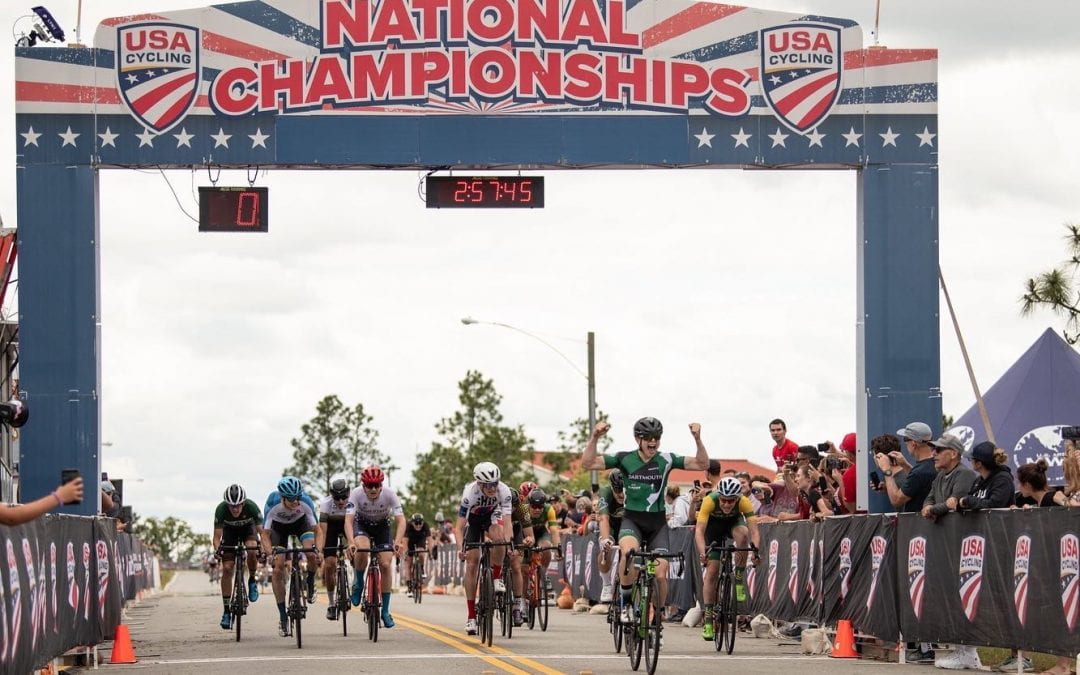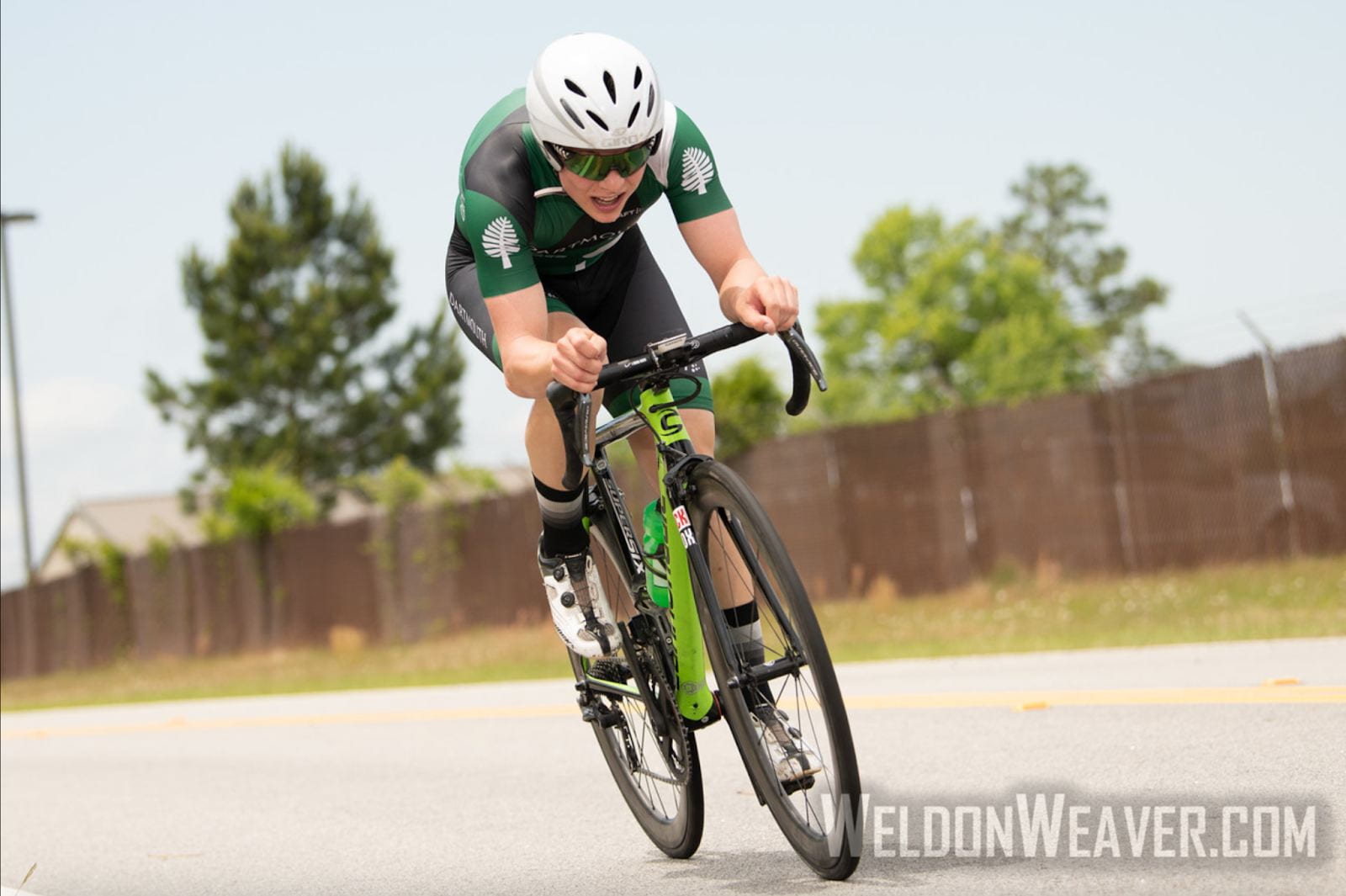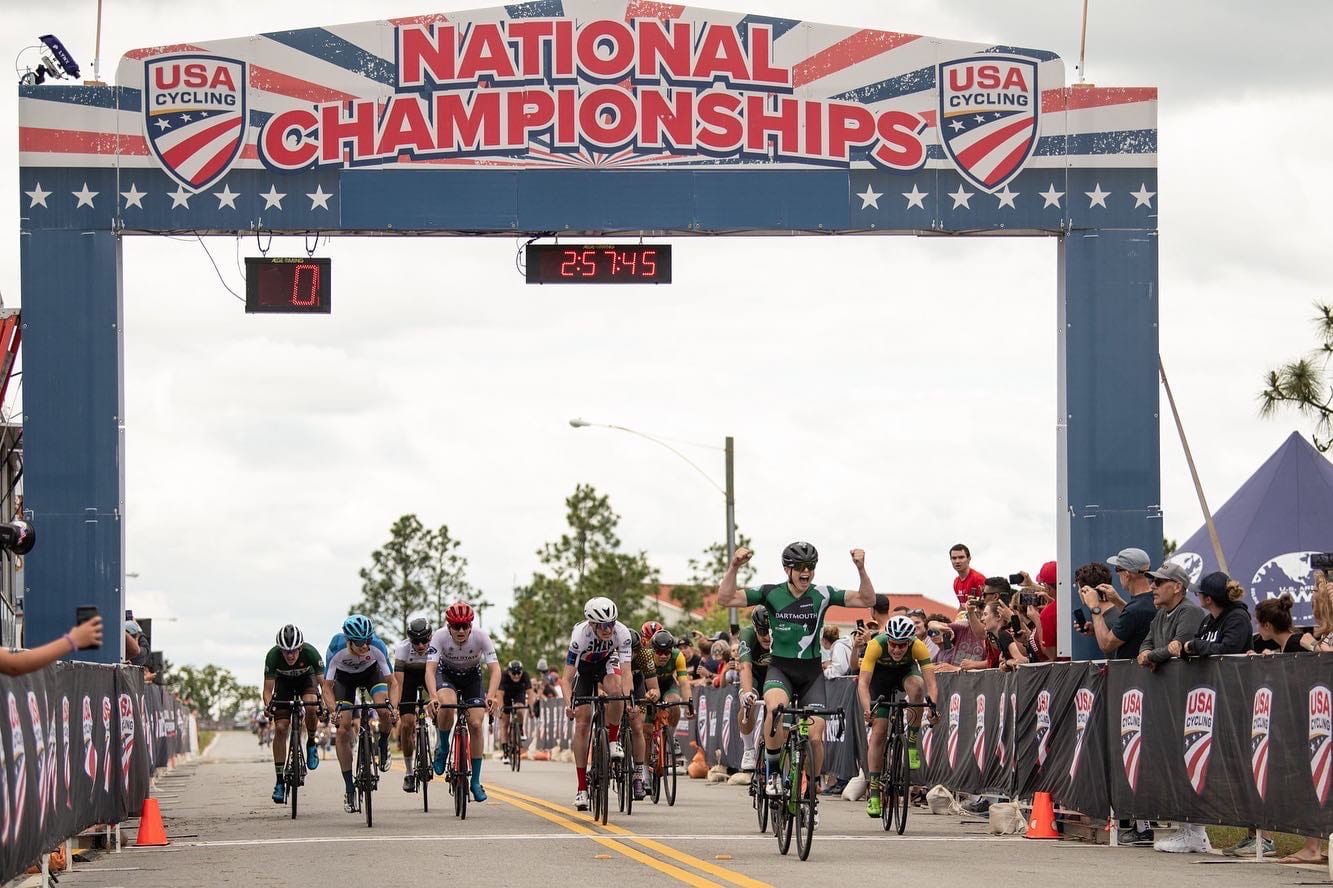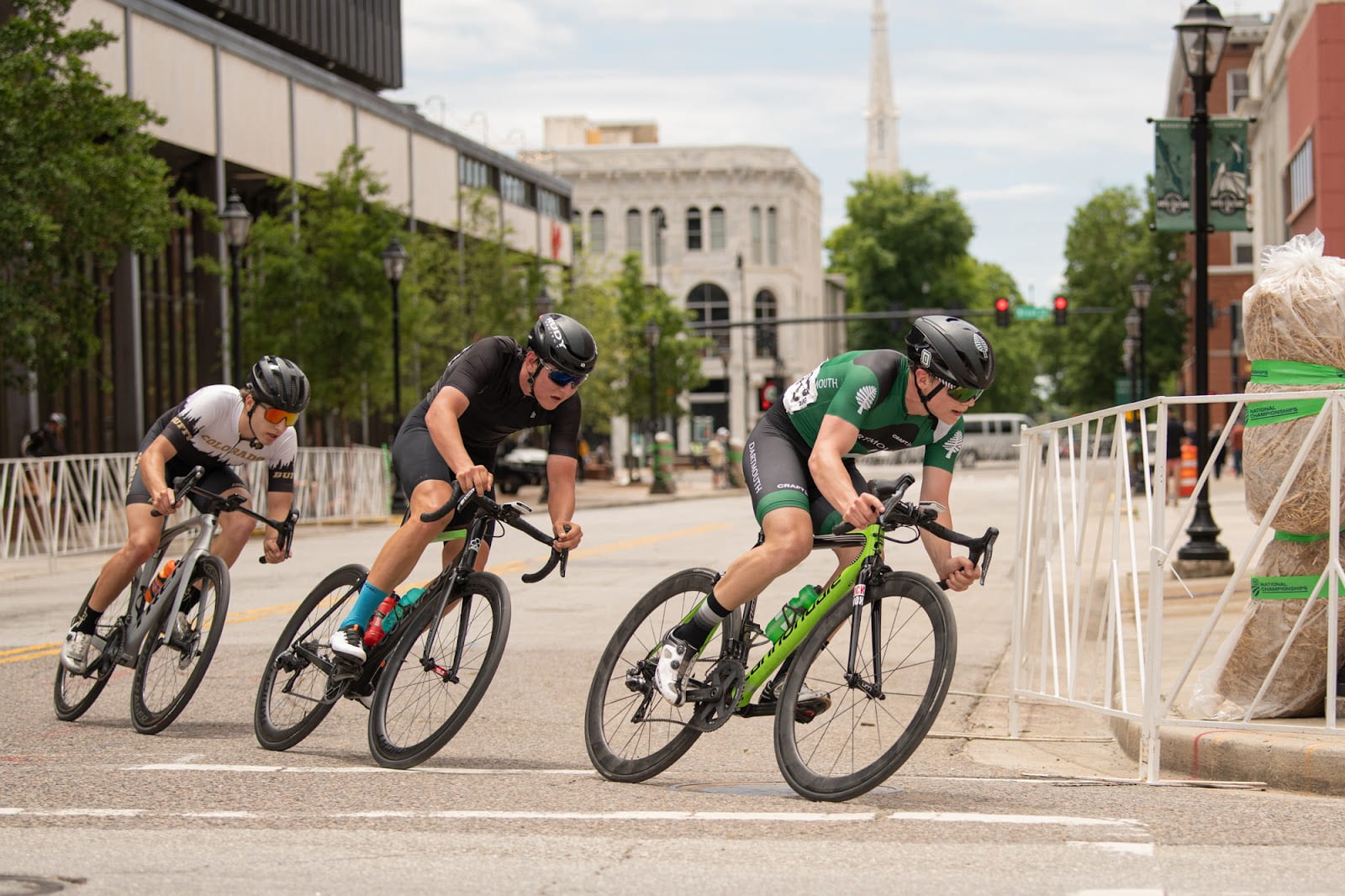Wells Willett, Dartmouth College sophomore (Class of 2024) had a stellar weekend of racing in the sweltering heat and humidity, capping off his collegiate racing season with some impressive performances. Read on for Wells’s race report and Bell Lap Coaching’s Steve Weller’s file analysis. Wells’s victory in the road race and 2nd place crit finish netted Wells the individual omnium championship! Congratulations, Wells!
Background info:
The Eastern Collegiate Cycling Conference race calendar is a dense, 5-weekend schedule that culminates in the National Championships. The race weekends are typically comprised of three races: a road race, criterium, team time trial. Dartmouth’s home race added an individual time trial to the schedule, for a total of 4 races in two days.
The overall number of race weekends in the ECCC road season has gradually decreased over the years, but the demands of the race-heavy weekends haven’t diminished. Wells and the team have some of the longest drives to races in the eastern conference, which adds a mental and physical toll for the collegiate athletes, on top of their academic demands. With so many races in a short period of time, it quickly becomes challenging for many racers to recover well after one weekend, to try to squeeze in a little training, and to find fresh legs for the next race weekend.
 The Dartmouth College Cycling Team, Spring 2022.
The Dartmouth College Cycling Team, Spring 2022.
Despite the density of the ECCC calendar, Wells was able to maintain his weight (150 pounds) and threshold power (365 watts) steadily through the season. Let’s dive into Wells’ road race and crit files from Nationals to see how he put his fitness and race-honed skills to use!
Day 1, time trial:
Wells placed 7th in the 22.2 km individual time trial, coming off of stressful and delayed travel en route to Georgia: “After a long day of travel, in 90+ degree weather, the legs didn’t show up. Thankfully, the rolling course allowed me some rest, and I had done a lot of work on my time trial position. I took 7th on the day (Varsity and Club combined).” Wells used lengths of nylon stockings packed with ice cubes to try to beat the heat. A common practice at hot races, these ice socks can help keep body temperature down, and Wells noted that he started the time trial with 3 ice socks, all of which melted in the first 10 minutes of the race.
Day 2, road race:
Wells smartly did some research on past races held on the same 120 km / 75 mile road course. “Cooler weather and a breeze on Saturday made for perfect race conditions. After watching both womens races come down to field sprints, it seemed like all the road races would stay together for a sprint finish. I also talked with the 2019 road race winner, Evan Bausbacher, about his success and he noted how the course favored a pack finish.”
Having a sense of how races have historically played out on a course and knowing your competitors can give a racer an edge against their competitors, and should be part of pre-race preparation at every event.
Wells talks about the race, and we can see how his pre-race homework played out: “The race went off with a bang. As predicted, attacks off the front were immediately reeled back on the open and fast terrain. I conserved energy for the first four (out of five) laps, tailgunning at all times except to bridge across threatening splits in the pack. At the start of lap five, a solo rider from Maryland launched a threatening solo attack. CU Boulder (the team to beat, with 6 strong riders in the field) hit the front to reel him in. From my conversation with Evan, I knew that this exact thing had happened in 2019, when CU Boulder burned themselves on the last lap bringing back a breakaway. I stayed calm in 10th wheel for the last 20km while CU Boulder cobbled together a disorganized chase that only brought back the Maryland rider 2km from the finish line.”
Image #1: Overview of road race power, HR, and elevation data as seen in TrainingPeaks.
“The last kilometer of the course featured a short downhill into a .5 km uphill, followed by a 400 meter flat drag to the finish. Riders started attacking but I kept the effort smooth, moving up to 5th wheel by the top of the climb. Over the top, the first person opened their sprint, and I immediately followed, because a tailwind meant that the 350 meter sprint would be over in just a few short seconds. After a star race, I had the legs to come around the last riders and post up at the line.”
Ladies and gentlemen, your 2022 Collegiate National Road Race Champion, Wells Willett!
A successful season of racing leading up to Nationals helped Wells learn the dynamics of group racing and team tactics, and we can see he put his experience and racecraft to good use!
Race Data Notes:
When I look at race data in either TrainingPeaks or the more powerful WKO5, I often start by finding where certain peak power outputs occur relative to the duration of the race. It is common, especially with newer racers, to see peak power outputs in the early parts of a race: pre-race nerves can lead to a state of anticipation and high arousal, resulting in hard (and costly) efforts from fresh legs.
Where did Wells throw down his biggest watts in the road race? In Image #1, you can see that his peak 20 minute and 30 minute power outputs came at around 2 hours and 22 minutes – not until the tail end of lap 4.
What’s even more telling (and what I love to see in a race file) is that Wells’s peak 2 minute power comes at the end of the race, leading right into his final victorious sprint! Good pre-race preparation, paying attention to team tactics within the race, and smartly conserving his energy all factored into this great performance.
Image #2: Road race data file, with peak 5 minute and 2 minute power highlighted in the shaded areas of the profile.
Day 3, Criterium:
The third and final race of the championship weekend was a pancake flat, 4-corner course built for speed. With a big target on his back after Saturday’s result, Wells had his work cut out for him in the crit, finding racers following his every move in the race.
Wells leading a group of three in the crit.
“The crit was hard from the gun. On a fast four corner crit littered with potholes, it was challenging to conserve energy. Roughly 30 minutes into the race, I started attacking and following attacks. I was marked though, and quickly reeled in. After one break stuck for a few laps, it began to seem like the race might be won from a breakaway, so I followed nearly every one after that.”
Image #4: Overview of file from the Nationals criterium.
“A few attempts later, one stuck with 30 minutes to go in the race, and it had a CU Boulder rider in it, so I knew they would be disrupting the chase effort behind. There were three of us in the break, with two of us working while the CU Boulder rider sat on. We were holding a gap of around 10 seconds, with the field never letting us out of sight. With 2 laps to go, a rider from UCLA bridged across to the break and sat on the back. In the final lap, I glanced back to see the field closing us, only a couple hundred meters away. While three of us looked at each other to make the first move, UCLA opened his sprint through the last corner. The rest of us started sprinting, but it was too late to catch him. I took second, securing the individual omnium for the weekend!”
Race Data Notes:
Similar to the road race, Wells produced the majority of his highest average power outputs late in the criterium. We can see his peak 5 minute power output at the start of the final break of 3 riders, and his peak 1 minute power as part of his positioning for the final sprint.
Image #5: Peak 5 min. and 1 min. power from the crit, highlighted in the shaded areas of the power profile.
Even after some challenging travel from New Hampshire to Georgia, and with two days of racing already in his legs, Wells rode another strong and smart race. Criteriums are far from predictable, with dynamics and team tactics changing nearly every lap. We see that Wells positioned himself well on the crowded course, setting him up to establish the decisive break away of the day. After nearly 80 minutes of hard racing in his legs, Wells’s depth of fitness and competitive grit helped him dig deep for his 2nd podium in two days, leading to a well-deserved victory in the omnium championship.
Congrats to Wells and all the collegiate racers who made it to this year’s championships!








